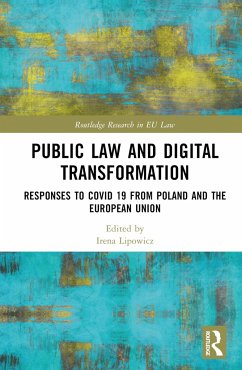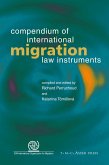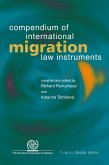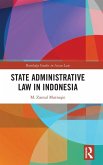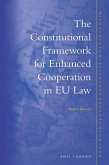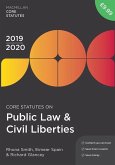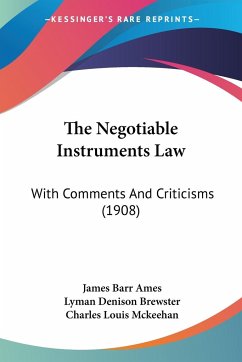Instruments of Public Law
Digital Transformation during the Pandemic
Herausgeber: Lipowicz, Irena; Syrt, Aleksandra; Szpor, Gra&
Instruments of Public Law
Digital Transformation during the Pandemic
Herausgeber: Lipowicz, Irena; Syrt, Aleksandra; Szpor, Gra&
- Gebundenes Buch
- Merkliste
- Auf die Merkliste
- Bewerten Bewerten
- Teilen
- Produkt teilen
- Produkterinnerung
- Produkterinnerung
The Covid 19 pandemic has revealed the need to verify the existing principles of functioning of public authorities, in relation to various decision-making processes, both at the conceptual level and at law implementation.
Andere Kunden interessierten sich auch für
![Compendium of International Migration Law Instruments Compendium of International Migration Law Instruments]() Richard Perruchoud / Katarina Tomolova (eds.)Compendium of International Migration Law Instruments85,99 €
Richard Perruchoud / Katarina Tomolova (eds.)Compendium of International Migration Law Instruments85,99 €![Compendium of International Migration Law Instruments Compendium of International Migration Law Instruments]() Richard Perruchoud / Katarina Tomolova (eds.)Compendium of International Migration Law Instruments40,99 €
Richard Perruchoud / Katarina Tomolova (eds.)Compendium of International Migration Law Instruments40,99 €![State Administrative Law in Indonesia State Administrative Law in Indonesia]() M Zaenul MuttaqinState Administrative Law in Indonesia198,99 €
M Zaenul MuttaqinState Administrative Law in Indonesia198,99 €![Australian Critical Decisions Australian Critical Decisions]() Australian Critical Decisions197,99 €
Australian Critical Decisions197,99 €![The Constitutional Framework for Enhanced Cooperation in EU Law The Constitutional Framework for Enhanced Cooperation in EU Law]() Robert BöttnerThe Constitutional Framework for Enhanced Cooperation in EU Law253,99 €
Robert BöttnerThe Constitutional Framework for Enhanced Cooperation in EU Law253,99 €![Core Statutes on Public Law & Civil Liberties 2019-20 Core Statutes on Public Law & Civil Liberties 2019-20]() Rhona SmithCore Statutes on Public Law & Civil Liberties 2019-2018,99 €
Rhona SmithCore Statutes on Public Law & Civil Liberties 2019-2018,99 €![The Negotiable Instruments Law The Negotiable Instruments Law]() James Barr AmesThe Negotiable Instruments Law32,99 €
James Barr AmesThe Negotiable Instruments Law32,99 €-
-
-
The Covid 19 pandemic has revealed the need to verify the existing principles of functioning of public authorities, in relation to various decision-making processes, both at the conceptual level and at law implementation.
Hinweis: Dieser Artikel kann nur an eine deutsche Lieferadresse ausgeliefert werden.
Hinweis: Dieser Artikel kann nur an eine deutsche Lieferadresse ausgeliefert werden.
Produktdetails
- Produktdetails
- Verlag: Taylor & Francis
- Seitenzahl: 350
- Erscheinungstermin: 28. November 2022
- Englisch
- Abmessung: 234mm x 156mm x 22mm
- Gewicht: 694g
- ISBN-13: 9781032205151
- ISBN-10: 1032205156
- Artikelnr.: 64673263
- Herstellerkennzeichnung
- Libri GmbH
- Europaallee 1
- 36244 Bad Hersfeld
- gpsr@libri.de
- Verlag: Taylor & Francis
- Seitenzahl: 350
- Erscheinungstermin: 28. November 2022
- Englisch
- Abmessung: 234mm x 156mm x 22mm
- Gewicht: 694g
- ISBN-13: 9781032205151
- ISBN-10: 1032205156
- Artikelnr.: 64673263
- Herstellerkennzeichnung
- Libri GmbH
- Europaallee 1
- 36244 Bad Hersfeld
- gpsr@libri.de
Irena Lipowicz is Full Professor in Law at Cardinal Stefan Wyszy¿ski University in Warsaw, Poland. Ombudsman in Poland in 2010-2015, Honorary Doctor of the Osnabrück University. Member of the Board of the Association of the European Public Law SIPE. Member of the United Nations University Council (UNU) 2016-2018 and Ombudsman in 2010-2015, Polish ambassador in Austria in 2000-2004. Gräyna Szpor is Full Professor in Law at Cardinal Stefan Wyszy¿ski University in Warsaw, Poland. Vice-president of the Sectoral Council for Telecommunications and Cybersecurity Competencies. Scientific editor of the 12-volume monograph "Openness and its limitations" (C.H. Beck Warsaw, 2013-2016) and 11 volumes of the "Internet" series (C.H. Beck, Warsaw 2011-2021). Aleksandra Syryt is Assistant Professor in Law at Cardinal Stefan Wyszy¿ski University in Warsaw, Poland. Member of Croatian-Polish Scientific Network and Central European Professors' Network. Plenipotentiary of the Rector of the Cardinal Stefan Wyszy¿ski University in Warsaw for legislative and legal matters. Lecturer at the National School of Public Administration in Poland.
DIGITAL TRANSFORMATION DURING THE PANDEMIC. INSTRUMENTS OF PUBLIC LAW *
INTRODUCTION *
I. GENERAL SUBJECTS *
1. THE NOTION OF DIGITAL TRANSFORMATION *
1. Introduction *
2. Structural analysis of juridisation *
3. Contextual analysis of occurrence in normative acts *
4. Explanations of a term "digital transformation" in the literature *
5. Digital transformation in public administration *
6. Conclusions *
2. THE PANDEMIC PHENOMENON - A FEW GENERAL REMARKS *
1. Introduction *
2. The term "pandemic" *
3. A short story about pandemic COVID-19 *
4. Pandemic and epidemic issues in Polish law and practice *
5. Conclusions *
3. PUBLIC LAW INSTRUMENTS *
1. Introduction *
2. Polish doctrine *
3. German doctrine *
1. Italian doctrine *
2. Conclusions *
II. EUROPEAN AND NATIONAL PUBLIC-LAW INSTRUMENTS *
1. THE DIGITAL TRANSFORMATION OF THE EUROPEAN UNION IN TIMES OF PANDEMIC -
SELECTED ISSUES OF PUBLIC LAW *
1. Introduction *
2. EU digital strategy *
3. Digital technologies: the EU response to a pandemic *
4. Implementation of the EU regulatory programme in Poland *
5. Form of measures taken by the EU: legal nature and legal basis *
6. The scope of measures taken by the EU: general characteristics *
7. Conclusions *
2. POLISH CONSTITUTIONAL INSTITUTIONS IN A PANDEMIC *
1. Introduction *
2. Constitutional tasks and obligations of the state regarding the response
to a pandemic *
3. The institution of constitutional extraordinary measures and pandemics *
4. The use of digital solutions in a pandemic - constitutional institutions
*
5. Conclusions *
3. USING TECHNOLOGY TO SUPPORT ADMINISTRATIONS IN CONTROLLING THE
SARS-COV-2 PANDEMIC *
1. Introduction *
2. The response of the technology *
3. The Italian Immuni app *
4. The problem of fragmentation in the urgency of the pandemic *
5. The need for centralized coordination and privacy concerns *
6. Should the use of an app like Immuni have been mandatory? A question of
proportionality *
7. The 2021 Regulation introducing an "interoperable EU Digital COVID
Certificate": from a subsidiarity and proportionality perspective *
8. Conclusions *
4. THE PANDEMIC AS A CHANCE FOR ADMINISTRATIVE MODERNIZATION: SOME NOTES
FROM GERMANY *
1. Introduction *
2. The current state of digitalization in Germany *
3. The pandemic as driver of the digital workplace and electronic public
procurement? *
4. Digital strategy to manage the pandemic crisis in Germany *
5. The German style of pandemic management: federalism and the rule of law
*
6. Conclusions *
5. PUBLIC INSTRUMENTS OF DIGITAL TRANSFORMATION DURING TIMES OF PANDEMIC IN
THE REPUBLIC OF CROATIA *
1. Introduction *
2. Short chronology of pandemic in the Republic of Croatia *
3. Brief overview of digital transformation and its components in the
Republic of Croatia in comparison to the EU *
4. Concise synopsis of Croatian public instruments of digital
transformation during times of pandemic *
5. Long-term future outlook of Croatian public instruments of digital
transformation *
6. Conclusions *
III. CYBERSECURITY *
1. INFORMATION SECURITY AND CYBERSECURITY IN A PANDEMIC *
1. Introduction *
2. Information and related rights *
3. Privacy protection and security of personal data *
4. Information security and cyber-security *
5. Interoperability of data processing during a pandemic *
6. Conclusions *
2. COUNTERING CYBERCRIME DURING THE PANDEMIC *
1. Introduction *
2. The impact of digital transformation of the state and economy and the
COVID - 19 pandemic on cybercrime *
3. Cyberattack scenarios involving COVID-19 *
4. Factors impeding the identification of the perpetrators *
5. De lege ferenda postulates *
6. Conclusions *
IV. HEALTH CARE AND SOCIAL SECURITY *
1. Telemedicine during the epidemic *
1. Introduction *
2. Modifications introduced by the outbreak of COVID-19 *
3. Conclusions *
2. EMERGENCY REMOTE TEACHING IN THE COVID-19 PANDEMIC ERA IN LIGHT OF THE
GDPR *
1. Introduction *
2. The legal landscape of data processing in ERT in Poland *
3. Actors involved in ERT and their responsibilities *
4. Principles of data processing and data subjects rights *
5. Conclusions *
3. STANDARDS OF PUBLIC ADMINISTRATION SERVICES FOR THE ELDERLY - A LESSON
IN PANDEMIC TIME *
1. Introduction *
2. References *
3. ICT as a support network for mental health and general physical
well-being *
4. Problems of long-term institutional care (LTC) standards *
5. Technology-enabledcare *
6. Conclusions *
4. PUBLIC E-SERVICES FOR PEOPLE WITH DISABILITIES DURING THE COVID-19
PANDEMIC *
1. Introduction *
2. A situation of people with disabilities *
3. Public e-service *
4. Barriers to accessing public services *
5. Analysis of the needs of people with disabilities in terms of access to
public e-services *
6. Analysis of selected public e-services in the era of Covid-19 *
7. Conclusions *
V. ADMINISTRATION IN A PANDEMIC *
1. ACCESS TO PUBLIC INFORMATION IN A PANDEMIC *
1. Introduction *
2. Principles of access to public information in the Republic of Poland *
3. Modification of regulations in the first period of the pandemic *
4. Assessment of legal solutions for limiting the right to information in
the first pandemic period *
5. Conclusion *
2. COMMON REMOTE ACCESS TO PUBLIC SPATIAL DATA IN A PANDEMIC SITUATION ON
THE EXAMPLE OF THE GEOPORTAL *
1. Introduction *
2. Geoportal as a point of common access to public data *
3. Data shared in the Geoportal during the pandemic *
3.1. Coronavirus related data, services and recommendations made available
on the Geoportal *
3.2. Accessibility to the new data *
4. The use of the Geoportal and activities promoting it *
5. Changes in existing regulations and common availability of public
spatial data *
5.1. Changes made by the "Shield 4.0" law *
5.2. Amendments to the Geodetic and Cartographic Law *
6. Conclusions *
3. VERIFICATION OF IDENTITY IN A PANDEMIC *
1. Introduction *
2. The concept and meaning of identity identification *
3. The impact of a pandemic on the identification process *
4. Biometric identification during a pandemic *
5. Conclusions *
4. REMOTE WORKING IN PUBLIC ADMINISTRATION DURING A PANDEMIC VERSUS DATA
PROTECTION *
1. Introduction *
2. Processing of employees' personal data in the context of remote working
*
3. Processing of personal data in remote working *
3.1. Organizational resources *
3.2. Technical resources *
4. Conclusions *
VI. ECONOMIC ACTIVITY AND FINANCIAL SYSTEM DURING A PANDEMIC *
SUPPORTING ENTREPRENEURSHIP DURING THE COVID-19 PANDEMIC *
1. Introduction *
2. Freedom of establishment and entrepreneurship *
3. Forms of support for entrepreneurship *
4. Conclusions *
1. IMPROVING THE ELECTRONIC COMMUNICATION OF THE TAXPAYER WITH THE TAX
AUTHORITIES DURING THE PANDEMIC *
1. Introduction *
2. Legal basis for obligations and powers to file tax returns
electronically *
3. Tax portals of tax administration bodies *
4. New e-services introduced in the pandemic period *
5. Other forms of communication between taxpayers and tax authorities *
6. Conclusions *
VII. EDUCATION IN A PANDEMIC *
1. PROBLEMS OF DIGITAL TRANSFORMATION OF UNIVERSITIES IN TIMES OF PANDEMIC
- FIRST EXPERIENCES *
3. Introduction *
4. Legal basis for the functioning of polish universities during the
pandemic *
5. The role of Shield 2.0 and Shield 4.0 to the functioning of universities
in times of pandemic *
6. Specific solutions resulting from the regulations of the MoSHE for the
functioning of HEIs during a pandemic *
1. Digital transformation - a challenge for universities *
2. Conclusions *
2. USE OF EDUCATIONAL APPLICATIONS, INCLUDING VIDEO GAMES, BY PUBLIC
ENTITIES DURING THE PANDEMIC *
3. Introduction *
2. Video games and educational apps as tools to support non-manual
information instruments of public actors in education *
3. Cooperation between public and commercial entities in the scope of using
video games to prevent the rapid and uncontrolled spread of the Coronavirus
*
4. The social significance of video games before and during a pandemic in
Poland *
5. Conclusions *
3. THE ROLE OF INFOGRAPHICS IN REDUCING UNCERTAINTY IN A PANDEMIC SITUATION
*
1. Introduction *
2. Forms of uncertainty reduction in the information society *
3. Characteristics of infographics and their usefulness during a pandemic *
4. The themes of the infographics *
5. Functions of infographics *
6. Internet dissemination *
7. Image proportions *
8. Use of infographics by public actors in a pandemic situation *
9. Conclusions *
FINAL REMARKS *
INTRODUCTION *
I. GENERAL SUBJECTS *
1. THE NOTION OF DIGITAL TRANSFORMATION *
1. Introduction *
2. Structural analysis of juridisation *
3. Contextual analysis of occurrence in normative acts *
4. Explanations of a term "digital transformation" in the literature *
5. Digital transformation in public administration *
6. Conclusions *
2. THE PANDEMIC PHENOMENON - A FEW GENERAL REMARKS *
1. Introduction *
2. The term "pandemic" *
3. A short story about pandemic COVID-19 *
4. Pandemic and epidemic issues in Polish law and practice *
5. Conclusions *
3. PUBLIC LAW INSTRUMENTS *
1. Introduction *
2. Polish doctrine *
3. German doctrine *
1. Italian doctrine *
2. Conclusions *
II. EUROPEAN AND NATIONAL PUBLIC-LAW INSTRUMENTS *
1. THE DIGITAL TRANSFORMATION OF THE EUROPEAN UNION IN TIMES OF PANDEMIC -
SELECTED ISSUES OF PUBLIC LAW *
1. Introduction *
2. EU digital strategy *
3. Digital technologies: the EU response to a pandemic *
4. Implementation of the EU regulatory programme in Poland *
5. Form of measures taken by the EU: legal nature and legal basis *
6. The scope of measures taken by the EU: general characteristics *
7. Conclusions *
2. POLISH CONSTITUTIONAL INSTITUTIONS IN A PANDEMIC *
1. Introduction *
2. Constitutional tasks and obligations of the state regarding the response
to a pandemic *
3. The institution of constitutional extraordinary measures and pandemics *
4. The use of digital solutions in a pandemic - constitutional institutions
*
5. Conclusions *
3. USING TECHNOLOGY TO SUPPORT ADMINISTRATIONS IN CONTROLLING THE
SARS-COV-2 PANDEMIC *
1. Introduction *
2. The response of the technology *
3. The Italian Immuni app *
4. The problem of fragmentation in the urgency of the pandemic *
5. The need for centralized coordination and privacy concerns *
6. Should the use of an app like Immuni have been mandatory? A question of
proportionality *
7. The 2021 Regulation introducing an "interoperable EU Digital COVID
Certificate": from a subsidiarity and proportionality perspective *
8. Conclusions *
4. THE PANDEMIC AS A CHANCE FOR ADMINISTRATIVE MODERNIZATION: SOME NOTES
FROM GERMANY *
1. Introduction *
2. The current state of digitalization in Germany *
3. The pandemic as driver of the digital workplace and electronic public
procurement? *
4. Digital strategy to manage the pandemic crisis in Germany *
5. The German style of pandemic management: federalism and the rule of law
*
6. Conclusions *
5. PUBLIC INSTRUMENTS OF DIGITAL TRANSFORMATION DURING TIMES OF PANDEMIC IN
THE REPUBLIC OF CROATIA *
1. Introduction *
2. Short chronology of pandemic in the Republic of Croatia *
3. Brief overview of digital transformation and its components in the
Republic of Croatia in comparison to the EU *
4. Concise synopsis of Croatian public instruments of digital
transformation during times of pandemic *
5. Long-term future outlook of Croatian public instruments of digital
transformation *
6. Conclusions *
III. CYBERSECURITY *
1. INFORMATION SECURITY AND CYBERSECURITY IN A PANDEMIC *
1. Introduction *
2. Information and related rights *
3. Privacy protection and security of personal data *
4. Information security and cyber-security *
5. Interoperability of data processing during a pandemic *
6. Conclusions *
2. COUNTERING CYBERCRIME DURING THE PANDEMIC *
1. Introduction *
2. The impact of digital transformation of the state and economy and the
COVID - 19 pandemic on cybercrime *
3. Cyberattack scenarios involving COVID-19 *
4. Factors impeding the identification of the perpetrators *
5. De lege ferenda postulates *
6. Conclusions *
IV. HEALTH CARE AND SOCIAL SECURITY *
1. Telemedicine during the epidemic *
1. Introduction *
2. Modifications introduced by the outbreak of COVID-19 *
3. Conclusions *
2. EMERGENCY REMOTE TEACHING IN THE COVID-19 PANDEMIC ERA IN LIGHT OF THE
GDPR *
1. Introduction *
2. The legal landscape of data processing in ERT in Poland *
3. Actors involved in ERT and their responsibilities *
4. Principles of data processing and data subjects rights *
5. Conclusions *
3. STANDARDS OF PUBLIC ADMINISTRATION SERVICES FOR THE ELDERLY - A LESSON
IN PANDEMIC TIME *
1. Introduction *
2. References *
3. ICT as a support network for mental health and general physical
well-being *
4. Problems of long-term institutional care (LTC) standards *
5. Technology-enabledcare *
6. Conclusions *
4. PUBLIC E-SERVICES FOR PEOPLE WITH DISABILITIES DURING THE COVID-19
PANDEMIC *
1. Introduction *
2. A situation of people with disabilities *
3. Public e-service *
4. Barriers to accessing public services *
5. Analysis of the needs of people with disabilities in terms of access to
public e-services *
6. Analysis of selected public e-services in the era of Covid-19 *
7. Conclusions *
V. ADMINISTRATION IN A PANDEMIC *
1. ACCESS TO PUBLIC INFORMATION IN A PANDEMIC *
1. Introduction *
2. Principles of access to public information in the Republic of Poland *
3. Modification of regulations in the first period of the pandemic *
4. Assessment of legal solutions for limiting the right to information in
the first pandemic period *
5. Conclusion *
2. COMMON REMOTE ACCESS TO PUBLIC SPATIAL DATA IN A PANDEMIC SITUATION ON
THE EXAMPLE OF THE GEOPORTAL *
1. Introduction *
2. Geoportal as a point of common access to public data *
3. Data shared in the Geoportal during the pandemic *
3.1. Coronavirus related data, services and recommendations made available
on the Geoportal *
3.2. Accessibility to the new data *
4. The use of the Geoportal and activities promoting it *
5. Changes in existing regulations and common availability of public
spatial data *
5.1. Changes made by the "Shield 4.0" law *
5.2. Amendments to the Geodetic and Cartographic Law *
6. Conclusions *
3. VERIFICATION OF IDENTITY IN A PANDEMIC *
1. Introduction *
2. The concept and meaning of identity identification *
3. The impact of a pandemic on the identification process *
4. Biometric identification during a pandemic *
5. Conclusions *
4. REMOTE WORKING IN PUBLIC ADMINISTRATION DURING A PANDEMIC VERSUS DATA
PROTECTION *
1. Introduction *
2. Processing of employees' personal data in the context of remote working
*
3. Processing of personal data in remote working *
3.1. Organizational resources *
3.2. Technical resources *
4. Conclusions *
VI. ECONOMIC ACTIVITY AND FINANCIAL SYSTEM DURING A PANDEMIC *
SUPPORTING ENTREPRENEURSHIP DURING THE COVID-19 PANDEMIC *
1. Introduction *
2. Freedom of establishment and entrepreneurship *
3. Forms of support for entrepreneurship *
4. Conclusions *
1. IMPROVING THE ELECTRONIC COMMUNICATION OF THE TAXPAYER WITH THE TAX
AUTHORITIES DURING THE PANDEMIC *
1. Introduction *
2. Legal basis for obligations and powers to file tax returns
electronically *
3. Tax portals of tax administration bodies *
4. New e-services introduced in the pandemic period *
5. Other forms of communication between taxpayers and tax authorities *
6. Conclusions *
VII. EDUCATION IN A PANDEMIC *
1. PROBLEMS OF DIGITAL TRANSFORMATION OF UNIVERSITIES IN TIMES OF PANDEMIC
- FIRST EXPERIENCES *
3. Introduction *
4. Legal basis for the functioning of polish universities during the
pandemic *
5. The role of Shield 2.0 and Shield 4.0 to the functioning of universities
in times of pandemic *
6. Specific solutions resulting from the regulations of the MoSHE for the
functioning of HEIs during a pandemic *
1. Digital transformation - a challenge for universities *
2. Conclusions *
2. USE OF EDUCATIONAL APPLICATIONS, INCLUDING VIDEO GAMES, BY PUBLIC
ENTITIES DURING THE PANDEMIC *
3. Introduction *
2. Video games and educational apps as tools to support non-manual
information instruments of public actors in education *
3. Cooperation between public and commercial entities in the scope of using
video games to prevent the rapid and uncontrolled spread of the Coronavirus
*
4. The social significance of video games before and during a pandemic in
Poland *
5. Conclusions *
3. THE ROLE OF INFOGRAPHICS IN REDUCING UNCERTAINTY IN A PANDEMIC SITUATION
*
1. Introduction *
2. Forms of uncertainty reduction in the information society *
3. Characteristics of infographics and their usefulness during a pandemic *
4. The themes of the infographics *
5. Functions of infographics *
6. Internet dissemination *
7. Image proportions *
8. Use of infographics by public actors in a pandemic situation *
9. Conclusions *
FINAL REMARKS *
DIGITAL TRANSFORMATION DURING THE PANDEMIC. INSTRUMENTS OF PUBLIC LAW *
INTRODUCTION *
I. GENERAL SUBJECTS *
1. THE NOTION OF DIGITAL TRANSFORMATION *
1. Introduction *
2. Structural analysis of juridisation *
3. Contextual analysis of occurrence in normative acts *
4. Explanations of a term "digital transformation" in the literature *
5. Digital transformation in public administration *
6. Conclusions *
2. THE PANDEMIC PHENOMENON - A FEW GENERAL REMARKS *
1. Introduction *
2. The term "pandemic" *
3. A short story about pandemic COVID-19 *
4. Pandemic and epidemic issues in Polish law and practice *
5. Conclusions *
3. PUBLIC LAW INSTRUMENTS *
1. Introduction *
2. Polish doctrine *
3. German doctrine *
1. Italian doctrine *
2. Conclusions *
II. EUROPEAN AND NATIONAL PUBLIC-LAW INSTRUMENTS *
1. THE DIGITAL TRANSFORMATION OF THE EUROPEAN UNION IN TIMES OF PANDEMIC -
SELECTED ISSUES OF PUBLIC LAW *
1. Introduction *
2. EU digital strategy *
3. Digital technologies: the EU response to a pandemic *
4. Implementation of the EU regulatory programme in Poland *
5. Form of measures taken by the EU: legal nature and legal basis *
6. The scope of measures taken by the EU: general characteristics *
7. Conclusions *
2. POLISH CONSTITUTIONAL INSTITUTIONS IN A PANDEMIC *
1. Introduction *
2. Constitutional tasks and obligations of the state regarding the response
to a pandemic *
3. The institution of constitutional extraordinary measures and pandemics *
4. The use of digital solutions in a pandemic - constitutional institutions
*
5. Conclusions *
3. USING TECHNOLOGY TO SUPPORT ADMINISTRATIONS IN CONTROLLING THE
SARS-COV-2 PANDEMIC *
1. Introduction *
2. The response of the technology *
3. The Italian Immuni app *
4. The problem of fragmentation in the urgency of the pandemic *
5. The need for centralized coordination and privacy concerns *
6. Should the use of an app like Immuni have been mandatory? A question of
proportionality *
7. The 2021 Regulation introducing an "interoperable EU Digital COVID
Certificate": from a subsidiarity and proportionality perspective *
8. Conclusions *
4. THE PANDEMIC AS A CHANCE FOR ADMINISTRATIVE MODERNIZATION: SOME NOTES
FROM GERMANY *
1. Introduction *
2. The current state of digitalization in Germany *
3. The pandemic as driver of the digital workplace and electronic public
procurement? *
4. Digital strategy to manage the pandemic crisis in Germany *
5. The German style of pandemic management: federalism and the rule of law
*
6. Conclusions *
5. PUBLIC INSTRUMENTS OF DIGITAL TRANSFORMATION DURING TIMES OF PANDEMIC IN
THE REPUBLIC OF CROATIA *
1. Introduction *
2. Short chronology of pandemic in the Republic of Croatia *
3. Brief overview of digital transformation and its components in the
Republic of Croatia in comparison to the EU *
4. Concise synopsis of Croatian public instruments of digital
transformation during times of pandemic *
5. Long-term future outlook of Croatian public instruments of digital
transformation *
6. Conclusions *
III. CYBERSECURITY *
1. INFORMATION SECURITY AND CYBERSECURITY IN A PANDEMIC *
1. Introduction *
2. Information and related rights *
3. Privacy protection and security of personal data *
4. Information security and cyber-security *
5. Interoperability of data processing during a pandemic *
6. Conclusions *
2. COUNTERING CYBERCRIME DURING THE PANDEMIC *
1. Introduction *
2. The impact of digital transformation of the state and economy and the
COVID - 19 pandemic on cybercrime *
3. Cyberattack scenarios involving COVID-19 *
4. Factors impeding the identification of the perpetrators *
5. De lege ferenda postulates *
6. Conclusions *
IV. HEALTH CARE AND SOCIAL SECURITY *
1. Telemedicine during the epidemic *
1. Introduction *
2. Modifications introduced by the outbreak of COVID-19 *
3. Conclusions *
2. EMERGENCY REMOTE TEACHING IN THE COVID-19 PANDEMIC ERA IN LIGHT OF THE
GDPR *
1. Introduction *
2. The legal landscape of data processing in ERT in Poland *
3. Actors involved in ERT and their responsibilities *
4. Principles of data processing and data subjects rights *
5. Conclusions *
3. STANDARDS OF PUBLIC ADMINISTRATION SERVICES FOR THE ELDERLY - A LESSON
IN PANDEMIC TIME *
1. Introduction *
2. References *
3. ICT as a support network for mental health and general physical
well-being *
4. Problems of long-term institutional care (LTC) standards *
5. Technology-enabledcare *
6. Conclusions *
4. PUBLIC E-SERVICES FOR PEOPLE WITH DISABILITIES DURING THE COVID-19
PANDEMIC *
1. Introduction *
2. A situation of people with disabilities *
3. Public e-service *
4. Barriers to accessing public services *
5. Analysis of the needs of people with disabilities in terms of access to
public e-services *
6. Analysis of selected public e-services in the era of Covid-19 *
7. Conclusions *
V. ADMINISTRATION IN A PANDEMIC *
1. ACCESS TO PUBLIC INFORMATION IN A PANDEMIC *
1. Introduction *
2. Principles of access to public information in the Republic of Poland *
3. Modification of regulations in the first period of the pandemic *
4. Assessment of legal solutions for limiting the right to information in
the first pandemic period *
5. Conclusion *
2. COMMON REMOTE ACCESS TO PUBLIC SPATIAL DATA IN A PANDEMIC SITUATION ON
THE EXAMPLE OF THE GEOPORTAL *
1. Introduction *
2. Geoportal as a point of common access to public data *
3. Data shared in the Geoportal during the pandemic *
3.1. Coronavirus related data, services and recommendations made available
on the Geoportal *
3.2. Accessibility to the new data *
4. The use of the Geoportal and activities promoting it *
5. Changes in existing regulations and common availability of public
spatial data *
5.1. Changes made by the "Shield 4.0" law *
5.2. Amendments to the Geodetic and Cartographic Law *
6. Conclusions *
3. VERIFICATION OF IDENTITY IN A PANDEMIC *
1. Introduction *
2. The concept and meaning of identity identification *
3. The impact of a pandemic on the identification process *
4. Biometric identification during a pandemic *
5. Conclusions *
4. REMOTE WORKING IN PUBLIC ADMINISTRATION DURING A PANDEMIC VERSUS DATA
PROTECTION *
1. Introduction *
2. Processing of employees' personal data in the context of remote working
*
3. Processing of personal data in remote working *
3.1. Organizational resources *
3.2. Technical resources *
4. Conclusions *
VI. ECONOMIC ACTIVITY AND FINANCIAL SYSTEM DURING A PANDEMIC *
SUPPORTING ENTREPRENEURSHIP DURING THE COVID-19 PANDEMIC *
1. Introduction *
2. Freedom of establishment and entrepreneurship *
3. Forms of support for entrepreneurship *
4. Conclusions *
1. IMPROVING THE ELECTRONIC COMMUNICATION OF THE TAXPAYER WITH THE TAX
AUTHORITIES DURING THE PANDEMIC *
1. Introduction *
2. Legal basis for obligations and powers to file tax returns
electronically *
3. Tax portals of tax administration bodies *
4. New e-services introduced in the pandemic period *
5. Other forms of communication between taxpayers and tax authorities *
6. Conclusions *
VII. EDUCATION IN A PANDEMIC *
1. PROBLEMS OF DIGITAL TRANSFORMATION OF UNIVERSITIES IN TIMES OF PANDEMIC
- FIRST EXPERIENCES *
3. Introduction *
4. Legal basis for the functioning of polish universities during the
pandemic *
5. The role of Shield 2.0 and Shield 4.0 to the functioning of universities
in times of pandemic *
6. Specific solutions resulting from the regulations of the MoSHE for the
functioning of HEIs during a pandemic *
1. Digital transformation - a challenge for universities *
2. Conclusions *
2. USE OF EDUCATIONAL APPLICATIONS, INCLUDING VIDEO GAMES, BY PUBLIC
ENTITIES DURING THE PANDEMIC *
3. Introduction *
2. Video games and educational apps as tools to support non-manual
information instruments of public actors in education *
3. Cooperation between public and commercial entities in the scope of using
video games to prevent the rapid and uncontrolled spread of the Coronavirus
*
4. The social significance of video games before and during a pandemic in
Poland *
5. Conclusions *
3. THE ROLE OF INFOGRAPHICS IN REDUCING UNCERTAINTY IN A PANDEMIC SITUATION
*
1. Introduction *
2. Forms of uncertainty reduction in the information society *
3. Characteristics of infographics and their usefulness during a pandemic *
4. The themes of the infographics *
5. Functions of infographics *
6. Internet dissemination *
7. Image proportions *
8. Use of infographics by public actors in a pandemic situation *
9. Conclusions *
FINAL REMARKS *
INTRODUCTION *
I. GENERAL SUBJECTS *
1. THE NOTION OF DIGITAL TRANSFORMATION *
1. Introduction *
2. Structural analysis of juridisation *
3. Contextual analysis of occurrence in normative acts *
4. Explanations of a term "digital transformation" in the literature *
5. Digital transformation in public administration *
6. Conclusions *
2. THE PANDEMIC PHENOMENON - A FEW GENERAL REMARKS *
1. Introduction *
2. The term "pandemic" *
3. A short story about pandemic COVID-19 *
4. Pandemic and epidemic issues in Polish law and practice *
5. Conclusions *
3. PUBLIC LAW INSTRUMENTS *
1. Introduction *
2. Polish doctrine *
3. German doctrine *
1. Italian doctrine *
2. Conclusions *
II. EUROPEAN AND NATIONAL PUBLIC-LAW INSTRUMENTS *
1. THE DIGITAL TRANSFORMATION OF THE EUROPEAN UNION IN TIMES OF PANDEMIC -
SELECTED ISSUES OF PUBLIC LAW *
1. Introduction *
2. EU digital strategy *
3. Digital technologies: the EU response to a pandemic *
4. Implementation of the EU regulatory programme in Poland *
5. Form of measures taken by the EU: legal nature and legal basis *
6. The scope of measures taken by the EU: general characteristics *
7. Conclusions *
2. POLISH CONSTITUTIONAL INSTITUTIONS IN A PANDEMIC *
1. Introduction *
2. Constitutional tasks and obligations of the state regarding the response
to a pandemic *
3. The institution of constitutional extraordinary measures and pandemics *
4. The use of digital solutions in a pandemic - constitutional institutions
*
5. Conclusions *
3. USING TECHNOLOGY TO SUPPORT ADMINISTRATIONS IN CONTROLLING THE
SARS-COV-2 PANDEMIC *
1. Introduction *
2. The response of the technology *
3. The Italian Immuni app *
4. The problem of fragmentation in the urgency of the pandemic *
5. The need for centralized coordination and privacy concerns *
6. Should the use of an app like Immuni have been mandatory? A question of
proportionality *
7. The 2021 Regulation introducing an "interoperable EU Digital COVID
Certificate": from a subsidiarity and proportionality perspective *
8. Conclusions *
4. THE PANDEMIC AS A CHANCE FOR ADMINISTRATIVE MODERNIZATION: SOME NOTES
FROM GERMANY *
1. Introduction *
2. The current state of digitalization in Germany *
3. The pandemic as driver of the digital workplace and electronic public
procurement? *
4. Digital strategy to manage the pandemic crisis in Germany *
5. The German style of pandemic management: federalism and the rule of law
*
6. Conclusions *
5. PUBLIC INSTRUMENTS OF DIGITAL TRANSFORMATION DURING TIMES OF PANDEMIC IN
THE REPUBLIC OF CROATIA *
1. Introduction *
2. Short chronology of pandemic in the Republic of Croatia *
3. Brief overview of digital transformation and its components in the
Republic of Croatia in comparison to the EU *
4. Concise synopsis of Croatian public instruments of digital
transformation during times of pandemic *
5. Long-term future outlook of Croatian public instruments of digital
transformation *
6. Conclusions *
III. CYBERSECURITY *
1. INFORMATION SECURITY AND CYBERSECURITY IN A PANDEMIC *
1. Introduction *
2. Information and related rights *
3. Privacy protection and security of personal data *
4. Information security and cyber-security *
5. Interoperability of data processing during a pandemic *
6. Conclusions *
2. COUNTERING CYBERCRIME DURING THE PANDEMIC *
1. Introduction *
2. The impact of digital transformation of the state and economy and the
COVID - 19 pandemic on cybercrime *
3. Cyberattack scenarios involving COVID-19 *
4. Factors impeding the identification of the perpetrators *
5. De lege ferenda postulates *
6. Conclusions *
IV. HEALTH CARE AND SOCIAL SECURITY *
1. Telemedicine during the epidemic *
1. Introduction *
2. Modifications introduced by the outbreak of COVID-19 *
3. Conclusions *
2. EMERGENCY REMOTE TEACHING IN THE COVID-19 PANDEMIC ERA IN LIGHT OF THE
GDPR *
1. Introduction *
2. The legal landscape of data processing in ERT in Poland *
3. Actors involved in ERT and their responsibilities *
4. Principles of data processing and data subjects rights *
5. Conclusions *
3. STANDARDS OF PUBLIC ADMINISTRATION SERVICES FOR THE ELDERLY - A LESSON
IN PANDEMIC TIME *
1. Introduction *
2. References *
3. ICT as a support network for mental health and general physical
well-being *
4. Problems of long-term institutional care (LTC) standards *
5. Technology-enabledcare *
6. Conclusions *
4. PUBLIC E-SERVICES FOR PEOPLE WITH DISABILITIES DURING THE COVID-19
PANDEMIC *
1. Introduction *
2. A situation of people with disabilities *
3. Public e-service *
4. Barriers to accessing public services *
5. Analysis of the needs of people with disabilities in terms of access to
public e-services *
6. Analysis of selected public e-services in the era of Covid-19 *
7. Conclusions *
V. ADMINISTRATION IN A PANDEMIC *
1. ACCESS TO PUBLIC INFORMATION IN A PANDEMIC *
1. Introduction *
2. Principles of access to public information in the Republic of Poland *
3. Modification of regulations in the first period of the pandemic *
4. Assessment of legal solutions for limiting the right to information in
the first pandemic period *
5. Conclusion *
2. COMMON REMOTE ACCESS TO PUBLIC SPATIAL DATA IN A PANDEMIC SITUATION ON
THE EXAMPLE OF THE GEOPORTAL *
1. Introduction *
2. Geoportal as a point of common access to public data *
3. Data shared in the Geoportal during the pandemic *
3.1. Coronavirus related data, services and recommendations made available
on the Geoportal *
3.2. Accessibility to the new data *
4. The use of the Geoportal and activities promoting it *
5. Changes in existing regulations and common availability of public
spatial data *
5.1. Changes made by the "Shield 4.0" law *
5.2. Amendments to the Geodetic and Cartographic Law *
6. Conclusions *
3. VERIFICATION OF IDENTITY IN A PANDEMIC *
1. Introduction *
2. The concept and meaning of identity identification *
3. The impact of a pandemic on the identification process *
4. Biometric identification during a pandemic *
5. Conclusions *
4. REMOTE WORKING IN PUBLIC ADMINISTRATION DURING A PANDEMIC VERSUS DATA
PROTECTION *
1. Introduction *
2. Processing of employees' personal data in the context of remote working
*
3. Processing of personal data in remote working *
3.1. Organizational resources *
3.2. Technical resources *
4. Conclusions *
VI. ECONOMIC ACTIVITY AND FINANCIAL SYSTEM DURING A PANDEMIC *
SUPPORTING ENTREPRENEURSHIP DURING THE COVID-19 PANDEMIC *
1. Introduction *
2. Freedom of establishment and entrepreneurship *
3. Forms of support for entrepreneurship *
4. Conclusions *
1. IMPROVING THE ELECTRONIC COMMUNICATION OF THE TAXPAYER WITH THE TAX
AUTHORITIES DURING THE PANDEMIC *
1. Introduction *
2. Legal basis for obligations and powers to file tax returns
electronically *
3. Tax portals of tax administration bodies *
4. New e-services introduced in the pandemic period *
5. Other forms of communication between taxpayers and tax authorities *
6. Conclusions *
VII. EDUCATION IN A PANDEMIC *
1. PROBLEMS OF DIGITAL TRANSFORMATION OF UNIVERSITIES IN TIMES OF PANDEMIC
- FIRST EXPERIENCES *
3. Introduction *
4. Legal basis for the functioning of polish universities during the
pandemic *
5. The role of Shield 2.0 and Shield 4.0 to the functioning of universities
in times of pandemic *
6. Specific solutions resulting from the regulations of the MoSHE for the
functioning of HEIs during a pandemic *
1. Digital transformation - a challenge for universities *
2. Conclusions *
2. USE OF EDUCATIONAL APPLICATIONS, INCLUDING VIDEO GAMES, BY PUBLIC
ENTITIES DURING THE PANDEMIC *
3. Introduction *
2. Video games and educational apps as tools to support non-manual
information instruments of public actors in education *
3. Cooperation between public and commercial entities in the scope of using
video games to prevent the rapid and uncontrolled spread of the Coronavirus
*
4. The social significance of video games before and during a pandemic in
Poland *
5. Conclusions *
3. THE ROLE OF INFOGRAPHICS IN REDUCING UNCERTAINTY IN A PANDEMIC SITUATION
*
1. Introduction *
2. Forms of uncertainty reduction in the information society *
3. Characteristics of infographics and their usefulness during a pandemic *
4. The themes of the infographics *
5. Functions of infographics *
6. Internet dissemination *
7. Image proportions *
8. Use of infographics by public actors in a pandemic situation *
9. Conclusions *
FINAL REMARKS *

